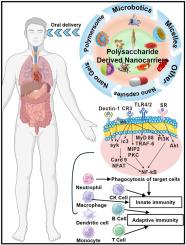Leveraging polysaccharide-derived nanocarriers to open new horizons in oral vaccine activation
IF 10.2
1区 医学
Q1 ENGINEERING, BIOMEDICAL
引用次数: 0
Abstract
Oral vaccines represent a transformative approach in immunization, offering non-invasive administration, mucosal immune activation, and improved patient compliance. However, their clinical translation is hindered by multiple physiological barriers, such as gastric degradation, enzymatic hydrolysis, and inefficient antigen uptake in gut-associated lymphoid tissues. This review explores the emerging role of polysaccharide-derived nanocarriers, particularly those inspired by traditional Chinese medicine (TCM), in addressing these challenges. We discuss how these biocompatible and biodegradable materials can be engineered to enhance antigen stability, promote targeted delivery to Peyer's patches, and stimulate robust mucosal and systemic immune responses. Key design principles—such as bioadhesion, structural tunability, and immunomodulatory capacity—are highlighted across various carrier systems. Moreover, we examine multifunctional delivery strategies, including co-delivery of adjuvants, pH-responsive release, and mucoadhesive platforms. Special emphasis is placed on the potential integration of polysaccharide nanocarriers into next-generation oral mRNA and nucleic acid vaccine technologies. These insights underscore the promise of polysaccharide-based nanotechnology as a cornerstone for future oral vaccine platforms, paving the way for non-invasive, scalable, and immunologically effective vaccination strategies.

利用多糖衍生的纳米载体开辟口服疫苗激活的新领域
口服疫苗代表了一种革命性的免疫方法,提供非侵入性给药,粘膜免疫激活,并改善了患者的依从性。然而,它们的临床转化受到多种生理障碍的阻碍,如胃降解、酶水解和肠道相关淋巴组织中抗原摄取效率低下。这篇综述探讨了多糖衍生纳米载体的新兴作用,特别是那些受到中医药启发的纳米载体,在解决这些挑战方面的作用。我们讨论了如何设计这些生物相容性和可生物降解的材料来增强抗原稳定性,促进靶向递送到Peyer's贴片,并刺激强健的粘膜和全身免疫反应。关键的设计原则,如生物粘附,结构可调性和免疫调节能力,强调在各种载体系统。此外,我们还研究了多功能递送策略,包括佐剂的共同递送、ph反应性释放和黏附平台。特别强调将多糖纳米载体整合到下一代口服mRNA和核酸疫苗技术中的可能性。这些见解强调了基于多糖的纳米技术作为未来口服疫苗平台的基石的前景,为非侵入性、可扩展和免疫有效的疫苗接种策略铺平了道路。
本文章由计算机程序翻译,如有差异,请以英文原文为准。
求助全文
约1分钟内获得全文
求助全文
来源期刊

Materials Today Bio
Multiple-
CiteScore
8.30
自引率
4.90%
发文量
303
审稿时长
30 days
期刊介绍:
Materials Today Bio is a multidisciplinary journal that specializes in the intersection between biology and materials science, chemistry, physics, engineering, and medicine. It covers various aspects such as the design and assembly of new structures, their interaction with biological systems, functionalization, bioimaging, therapies, and diagnostics in healthcare. The journal aims to showcase the most significant advancements and discoveries in this field. As part of the Materials Today family, Materials Today Bio provides rigorous peer review, quick decision-making, and high visibility for authors. It is indexed in Scopus, PubMed Central, Emerging Sources, Citation Index (ESCI), and Directory of Open Access Journals (DOAJ).
 求助内容:
求助内容: 应助结果提醒方式:
应助结果提醒方式:


